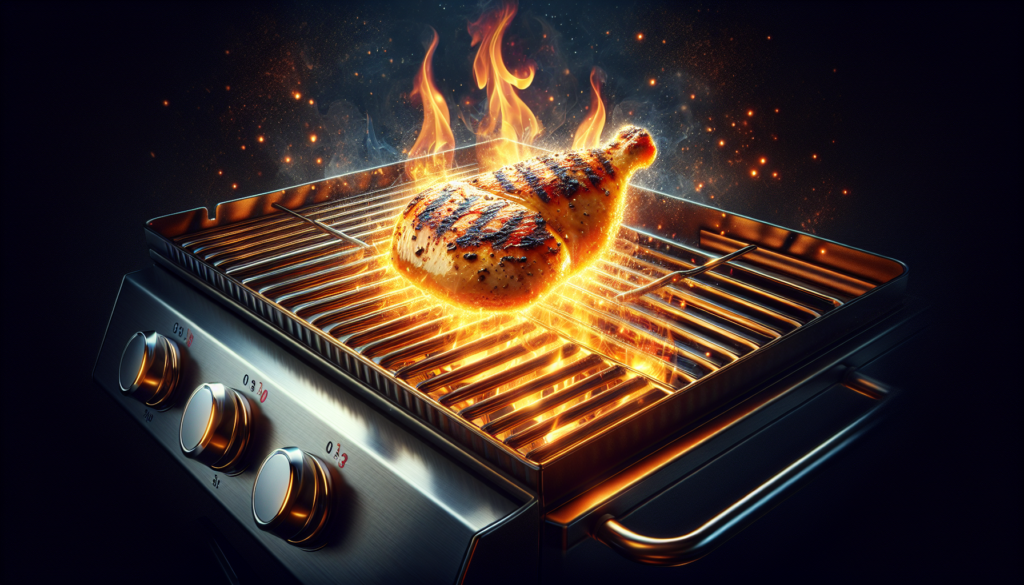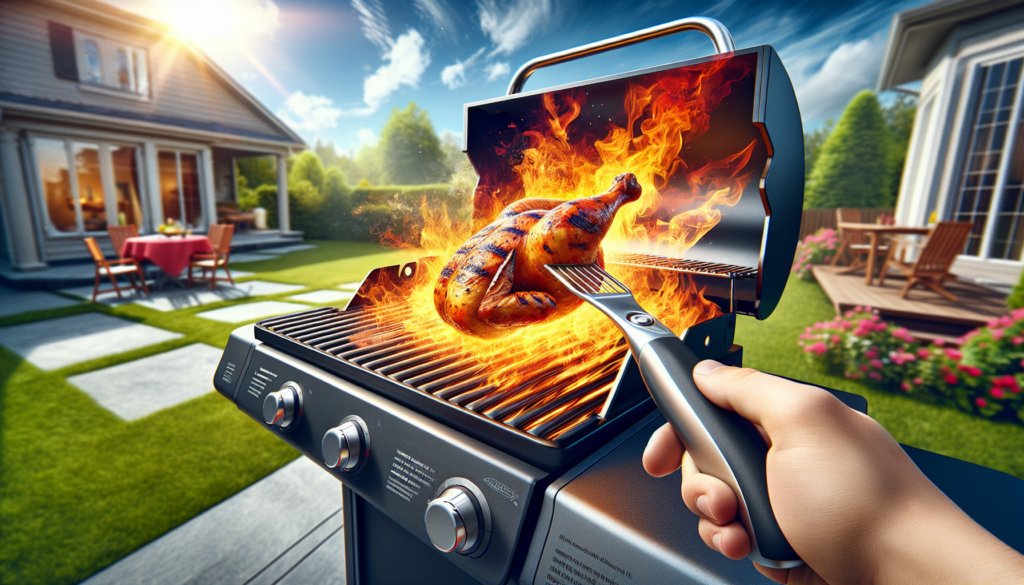Grilling chicken on a gas grill can be a delicious and convenient way to enjoy a summertime BBQ. In this article, you will discover the step-by-step process of achieving perfectly grilled chicken on your gas grill. From preparing the chicken to choosing the right temperature and cooking time, you will learn valuable tips and tricks that will make your grilled chicken juicy, flavorful, and irresistible. Get ready to impress your friends and family with your grilling skills as you master the art of grilling chicken on a gas grill.

Preparing the Chicken
Choosing the Chicken
When it comes to grilling chicken on a gas grill, choosing the right chicken is crucial. Opt for fresh, high-quality chicken rather than frozen chicken, as fresh chicken tends to have better flavor and texture. Look for chicken that is plump and has a healthy pink color. Whether you prefer bone-in or boneless chicken, make sure the pieces are evenly sized to ensure even cooking.
Trimming and Seasoning the Chicken
Before grilling the chicken, it’s important to trim any excess fat or skin. Trimming the chicken not only helps to reduce flare-ups while grilling but also ensures a more even and consistent cook. Seasoning the chicken is equally important to enhance its flavor. You can use a variety of seasonings such as salt, pepper, garlic powder, paprika, or your favorite spice rub to add a burst of deliciousness to the chicken. Make sure to coat the chicken evenly with the seasonings, paying attention to both sides.
Preheating the Gas Grill
Cleaning the Grill
Before preheating the gas grill, it’s essential to clean the grill grates to avoid any leftover residue from previous use. Use a wire brush to scrub the grates and remove any food particles or grease. Cleaning the grill grates not only promotes better tasting chicken but also helps prevent sticking.
Adjusting the Burner Settings
To preheat the gas grill, you need to adjust the burner settings accordingly. Turn on all the burners to their highest setting and close the lid. Allow the grill to heat up for around 10-15 minutes or until it reaches the desired temperature. Preheating the grill ensures that the chicken cooks evenly and helps to create beautiful grill marks.
Direct Heat vs. Indirect Heat
Understanding Direct Heat
Direct heat grilling involves cooking the chicken directly over the flames or heat source. This method is perfect for boneless chicken and smaller pieces of chicken, such as chicken breasts or wings. Direct heat grilling provides a quick cooking process, resulting in a slightly charred exterior and juicy interior.
Understanding Indirect Heat
Indirect heat grilling involves cooking the chicken away from the direct flames or heat source. This method is suitable for larger cuts of chicken, like whole chickens or bone-in chicken pieces. By cooking with indirect heat, the chicken is surrounded by hot air, resulting in slower and more even cooking. This method helps to avoid charring and allows the chicken to cook thoroughly.
Grilling Techniques
Oil the Grill Grates
To prevent sticking, it’s important to oil the grill grates before placing the chicken on them. Use a brush or folded paper towel to apply a thin layer of cooking oil to the grates. This not only prevents the chicken from sticking but also helps to create attractive grill marks and enhance the flavor.
Using Marinades and Basting
Marinating the chicken before grilling can add incredible flavor and tenderness. You can use a variety of marinades, such as citrus-based, herb-infused, or savory sauces, to enhance the taste of the chicken. Additionally, basting the chicken during grilling can help keep it moist and add an extra layer of flavor. Use a marinade brush to apply the marinade or basting sauce to the chicken as it cooks.
Proper Placement on the Grill
When grilling chicken, proper placement on the grill is essential for even cooking. For direct heat grilling, place boneless chicken or smaller pieces directly over the heat source. For indirect heat grilling, position bone-in chicken or larger cuts away from the heat source, ensuring they are not directly over the flames. This allows the chicken to cook evenly without burning.
Turning the Chicken
To achieve an even cook and attractive grill marks, it’s important to turn the chicken while grilling. Use tongs or a spatula to carefully flip the chicken halfway through the cooking process. This ensures that both sides of the chicken are exposed to the heat and get cooked evenly.
Using a Meat Thermometer
To ensure that the chicken is cooked to perfection and safe to eat, it’s recommended to use a meat thermometer. Insert the thermometer into the thickest part of the chicken, avoiding contact with bone. For bone-in chicken, the internal temperature should reach 165°F (74°C), while boneless chicken should reach 160°F (71°C). This guarantees that the chicken is both delicious and safe to consume.

Grilling Bone-In Chicken
Grilling Time and Temperature
For bone-in chicken like drumsticks or thighs, the recommended grilling temperature is medium-high, around 375-400°F (190-205°C). The cooking time can vary depending on the thickness of the chicken pieces, but it typically takes around 35-45 minutes. Ensure that the chicken is cooked through by using a meat thermometer.
Achieving a Crispy Skin
To achieve a crispy skin while grilling bone-in chicken, it’s helpful to start cooking the chicken skin-side down. This allows the fat to render and the skin to crisp up nicely. Once the skin is golden brown and crispy, you can flip the chicken to finish cooking it.
Testing for Doneness
To determine if the bone-in chicken is cooked, you can perform a simple doneness test. Pierce the thickest part of the chicken with a fork or skewer, and if the juices run clear with no trace of blood, the chicken is cooked. Additionally, using a meat thermometer is the most accurate way to confirm doneness.
Grilling Boneless Chicken
Grilling Time and Temperature
For boneless chicken breasts or thighs, the recommended grilling temperature is medium-high, around 375-400°F (190-205°C). Grilling boneless chicken takes less time compared to bone-in chicken, usually around 10-12 minutes per side. However, the cooking time may vary depending on the thickness of the chicken.
Ensuring Even Cooking
To ensure even cooking of boneless chicken, it’s advisable to pound the chicken breasts or thighs to an even thickness. This helps to ensure that the chicken cooks uniformly and prevents any portions from becoming overcooked or undercooked.
Checking for Doneness
To check if the boneless chicken is cooked, you can use the same doneness test as with bone-in chicken. Pierce the thickest part of the chicken with a fork or skewer, and if the juices run clear with no trace of pink, the chicken is cooked. Additionally, using a meat thermometer can provide a more accurate indication of doneness.
Grilling Chicken Pieces
Preparing and Seasoning the Pieces
When grilling chicken pieces like wings or drumsticks, it’s important to properly prepare and season them before placing them on the grill. Ensure the pieces are clean and dry, then season them with your choice of seasonings or marinade. This step adds flavor and enhances the taste of the chicken.
Grilling Time and Temperature
For chicken pieces, the recommended grilling temperature is medium-high, around 375-400°F (190-205°C). The grilling time depends on the size and thickness of the pieces, but it typically takes around 20-30 minutes. Turn the pieces occasionally during grilling to ensure even cooking.
Checking for Doneness
To check if the chicken pieces are cooked, use a meat thermometer to measure the internal temperature. For bone-in chicken pieces, ensure they reach an internal temperature of 165°F (74°C). For boneless chicken pieces, ensure they reach 160°F (71°C) internally. Juices should run clear with no traces of blood or pink color when the chicken is fully cooked.
Grilling Chicken Breasts
Creating Even Thickness
To ensure that chicken breasts cook evenly, it’s helpful to create an even thickness. Start by trimming any excess fat or tendons from the chicken breasts. Then, place each breast between two sheets of plastic wrap and gently pound them with a meat tenderizer or rolling pin until they have an even thickness. This helps to promote consistent cooking.
Grilling Time and Temperature
For chicken breasts, the recommended grilling temperature is medium-high, around 375-400°F (190-205°C). The grilling time varies depending on the thickness of the breasts but usually takes around 6-8 minutes per side. Flip the chicken breasts halfway through the cooking process to ensure even browning.
Using a Meat Tenderizer
Using a meat tenderizer on chicken breasts not only creates even thickness but also helps to enhance tenderness. By tenderizing the chicken breasts, they become more succulent and can absorb flavors better from marinades or seasoning.
Checking for Doneness
To check if the chicken breasts are fully cooked, use a meat thermometer to measure the internal temperature. They should reach an internal temperature of 160°F (71°C). Additionally, slice into the thickest part of the chicken breast, and if the juices run clear with no pink color, the breasts are ready to be served.
Gas Grill Accessories
Using Grill Mats
Grill mats are a fantastic accessory when grilling chicken on a gas grill. These non-stick mats are placed directly on the grill grates, preventing the chicken from sticking and making cleanup easier. Grill mats also help to retain the juices and flavors of the chicken, giving you perfectly cooked and flavorful results.
Utilizing a Grill Basket
A grill basket is a useful tool for grilling smaller pieces of chicken, such as wings or drumsticks. Place the chicken pieces in the basket and grill them without worrying about them falling through the grates. The grill basket keeps the chicken secure and allows for easy flipping and even cooking.
Using Skewers or Grill Racks
Skewers or grill racks are excellent accessories when grilling chicken kebabs or boneless chicken pieces. Skewers allow you to thread the chicken onto them and cook them evenly over the grill. Grill racks, on the other hand, provide a raised surface with individual slots to hold the chicken pieces, promoting even cooking and preventing them from sticking to the grill grates.
Safety Precautions
Proper Gas Tank Handling
When grilling on a gas grill, it’s important to handle the gas tank correctly to ensure safety. Always check the gas tank for leaks before igniting the grill. Make sure the gas tank is secure and in an upright position, away from any potential hazards. If you detect a gas leak or smell gas, immediately turn off the grill and contact a professional.
Preventing Cross-Contamination
To prevent cross-contamination and ensure food safety, it’s vital to practice proper hygiene while grilling. Use separate utensils and cutting boards for raw and cooked chicken to avoid any transfer of bacteria. Wash your hands thoroughly with soap and water after handling raw chicken and before touching any other food items.
Handling Flare-Ups
Flare-ups can occur when fat drippings from the chicken come into contact with the flames or heat source. To handle flare-ups, avoid panicking and keep the grill lid closed to starve the flames of oxygen. Move the chicken to a cooler part of the grill, or if necessary, temporarily turn off the burners until the flames subside.
Extinguishing the Flames
In the event of a fire or uncontrolled flames, it’s essential to know how to safely extinguish the flames. Keep a fire extinguisher nearby and familiarize yourself with its operation. If a fire occurs, turn off the gas supply and use the fire extinguisher following the manufacturer’s instructions. If the fire persists, call the fire department immediately.
Grilling chicken on a gas grill is an enjoyable and rewarding cooking method. With the right chicken selection, proper preparation, and attention to safety, you can create delicious and succulent grilled chicken every time. So fire up the grill, follow these tips, and get ready to savor the flavors of perfectly grilled chicken!
